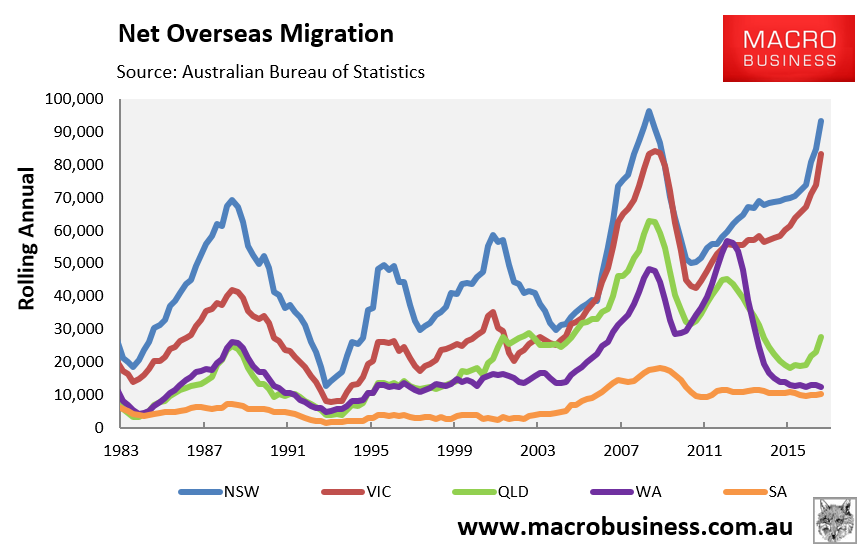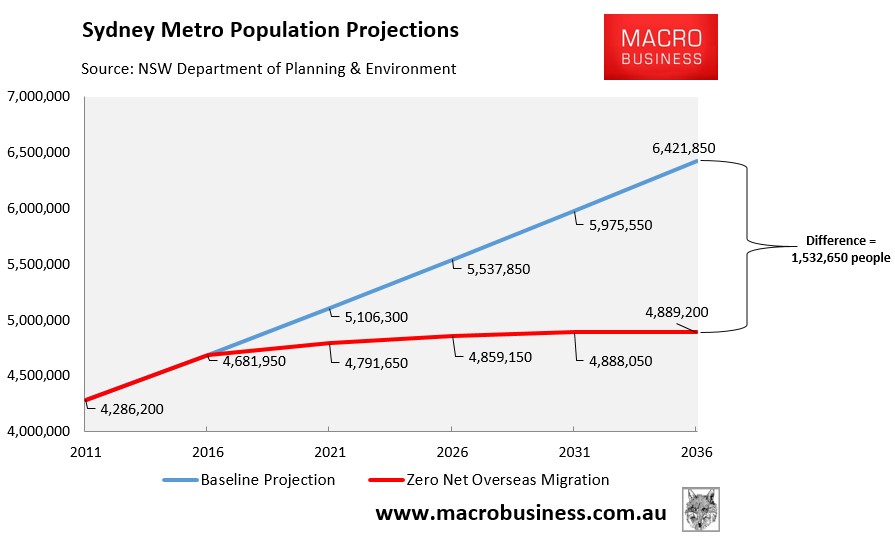I have noted repeatedly that one of the key reasons why Australia’s high population growth (immigration) is lowering the living standards of existing residents is because of the strain that it places on infrastructure, which inevitably leads to more congestion on roads, public transport, as well as more expensive housing.
Basic math (and commonsense) suggests that if you double the nation’s population, you need to at least double the stock of infrastructure to ensure that living standards are not eroded (other things equal).
In practice, however, the solution is not that simple. In already built-up cities like Sydney, which also happen to be the major magnet for new migrants (see next chart), the cost of retrofitting new infrastructure to accommodate greater population densities can become prohibitively expensive because of the need for land buy-backs, tunnelling, as well as disruptions to existing infrastructure.

In the case of Sydney, we have already witnessed these diseconomies of scale with the North West Rail Link, which is expected to cost an astounding $8.3 billion, as well as with the WestConnex road project – the $17 billion 33 kilometre motorway under construction that is more expensive per kilometre than the Chanel Tunnel.
Not only are these projects hideously expensive, but they often create major indigestion for Sydney residents during the construction phase. Moreover, in the case of WestConnex, existing free public roads like the state-owned M4 (that have already been paid off) will be tolled to help fund the project, raising costs for residents.
In fact, the cost of such projects is so great that the Grattan Institute estimated that “unprecedented infrastructure spending by states and territories” since the escalation of population growth from 2004 is “largely responsible for a $106 billion decline in their finances since 2006“, and that “after a threefold increase in capital spending over the last 10 years, states are paying 3 per cent more of their revenues in interest and depreciation”.
Last month, the hideous complexity and costs associated with the WestConnex road project have been further uncovered by The SMH, which reported that the private sector has steered clear from bidding to build the interchange at Rozelle in Sydney’s inner west because of the complexity.
And today, The SMH has revealed that the WestConnex project could actually worsen inner-west traffic congestion:
Commuters making the rat run through Sydney’s inner-west will face increasing congestion as a result of the WestConnex motorway, as new modelling reveals peak hour traffic will triple in volume on some local streets over the next five years.
The traffic study, commissioned by the Inner West council, predicts hundreds of additional cars will crawl through local streets and arterial roads in order to access the WestConnex motorway or avoid it, once construction is completed…
Inner West mayor Darcy Byrne said the study showed that “the opening of stage one of WestConnex will result in the mother of all rat runs through suburbs like Ashfield and Haberfield”.
“Thousands of Inner West residents will be forced to endure bumper-to-bumper traffic in their daily commute to work and when dropping their kids off to school,” he said…
Ken Welsh, the Inner West Council’s strategic transport planner, said the council’s study, which was produced by consulting firm Veitch Lister, was credible because it relied on traffic modelling used by the government’s road infrastructure agency, the Roads and Maritime Services…
In 2031, eight years after the project’s expected completion, some streets would still experience significant congestion in peak hour…
The RMS declined to comment directly on the study’s findings, but a spokesman said the agency’s modelling showed major roads would see significant decreases in traffic as a result of WestConnex.
“Daily heavy vehicle volumes on Parramatta Road and City West Link are forecast to drop by 40-50 per cent, and roads in the Inner West, such as Stanmore Road, Sydenham Road, Marrickville Road and King Street, are forecast to drop by 20-50 per cent,” he said.
$17 billion. A series of deep tunnels. These are the types of expensive and complicated infrastructure projects required to retrofit already built-out cities like Sydney to cater for rampant population growth. And the costs are borne by existing residents – either through higher taxes or expensive tolls.
Of course, anyone with half a brain knows what is driving the need for these complicated, costly projects: the federal government’s mass immigration program, which is primarily responsible for the 87,000 people per year projected increase in Sydney’s population to 6.4 million over the next 20-years, which would effectively add another Perth to the city’s population:

Blind Freddy can see that running a high immigration program requires massive investment and costs a lot, and that these costs are made worse by the diseconomies of scale discussed above. The huge infrastructure costs also force unpopular asset sales, increased debt borrowings and austerity – none of which is a desirable outcome.
Clearly, the most obvious and least cost policy solution to mitigate Sydney’s infrastructure woes is to significantly dial back Australia’s immigration program and forestall the need for costly new infrastructure projects in the first place. Because under current mass immigration settings, expensive solutions like WestConnex will be required over and over again as rapid population growth continually outstrips the supply of transport infrastructure. And existing residents will be forced to pay the cost, either through higher taxes or expensive tolls.

